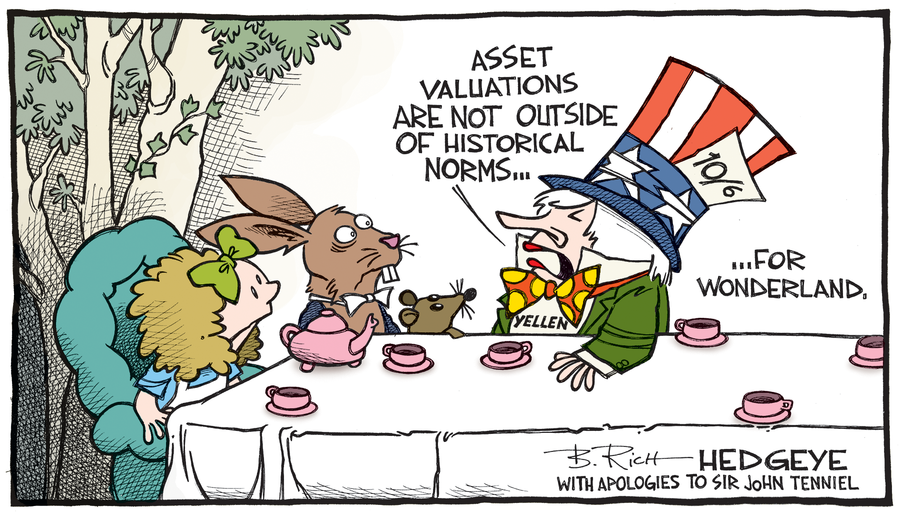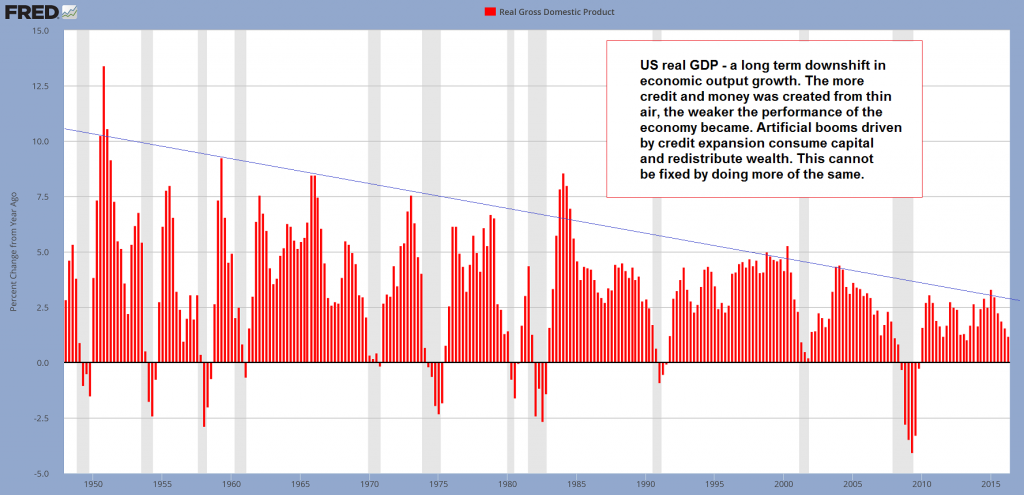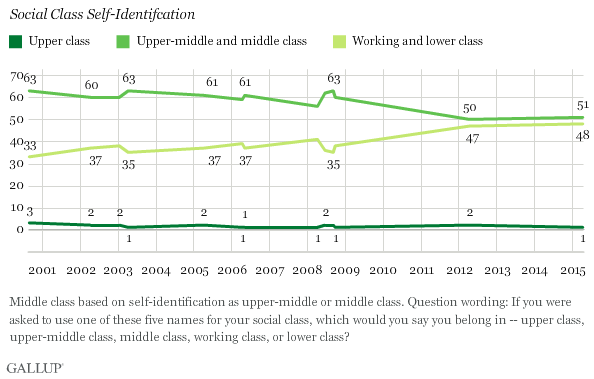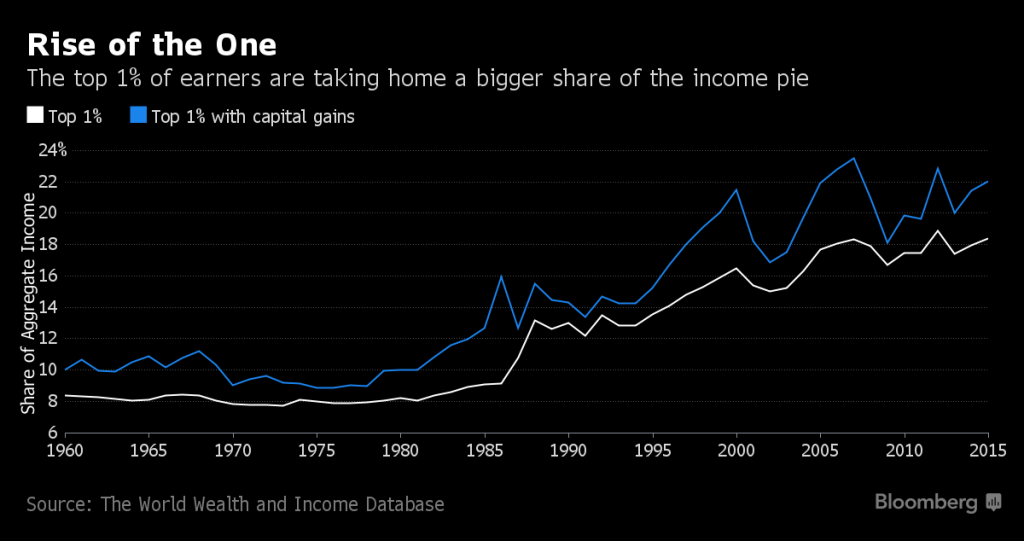Largest Theft in History As expected, Ms. Yellen smiled last week, announcing no change to the Fed’s extraordinary policies. For the last eight years, she has been aiding and abetting the largest theft in history. Thanks to ZIRP (zero-interest-rate policy) and QE (quantitative easing), every year, about 0 billion is transferred from largely middle-class savers to largely better-off speculators, financial asset owners, and the biggest borrowers during that period – corporations and the government. The financial press, nevertheless, finds something vaguely heroic about enabling the grandest larceny ever. Bloomberg: “Federal Reserve Chair Janet Yellen braved mounting opposition inside and outside the U.S. central bank and delayed an interest-rate increase again to give the economy more room to run.” Asset valuations are not outside of historical norms, particularly if one disregards the past 5,000 years. Cartoon by Bob Rich The U.S. economy is barely limping along. As we noted last week, when you adjust nominal GDP growth by a more accurate measure of inflation – David Stockman’s “Flyover CPI” – you see that the economy is actually in recession.
Topics:
Bill Bonner considers the following as important: Central Banks, David Stockman, Debt and the Fallacies of Paper Money, Featured, Federal Reserve, Janet Yellen, Jim Clifton, newslettersent, On Economy, U.S. Gross Domestic Product
This could be interesting, too:
Nachrichten Ticker - www.finanzen.ch writes Die Performance der Kryptowährungen in KW 9: Das hat sich bei Bitcoin, Ether & Co. getan
Nachrichten Ticker - www.finanzen.ch writes Wer verbirgt sich hinter der Ethereum-Technologie?
Marc Chandler writes March 2025 Monthly
Mark Thornton writes Is Amazon a Union-Busting Leviathan?
Largest Theft in HistoryAs expected, Ms. Yellen smiled last week, announcing no change to the Fed’s extraordinary policies. For the last eight years, she has been aiding and abetting the largest theft in history. Thanks to ZIRP (zero-interest-rate policy) and QE (quantitative easing), every year, about $300 billion is transferred from largely middle-class savers to largely better-off speculators, financial asset owners, and the biggest borrowers during that period – corporations and the government. The financial press, nevertheless, finds something vaguely heroic about enabling the grandest larceny ever. Bloomberg:
|
|
| The U.S. economy is barely limping along. As we noted last week, when you adjust nominal GDP growth by a more accurate measure of inflation – David Stockman’s “Flyover CPI” – you see that the economy is actually in recession. Room to run? It is backing up!
Bloomberg continues its brain-dead coverage:
|
U.S. Gross Domestic Product(see more posts on U.S. Gross Domestic Product, )We have numerous reservations about GDP as a measure of economic growth, but it will do for the purpose of showing the long term trend in output growth. It is worth noting that this downshift has occurred in tandem with accelerating credit and money supply growth. While there are other factors in play as well (such as the inexorable increase in regulations), this outcome is in line with Austrian business cycle theory, which posits that booms driven by credit expansion ultimately lead to capital consumption. |
Voodoo TradeWe listened to Ms. Yellen’s remarks. She sounded like a well-trained functionary, a technician. Lots of economic mumbo-jumbo. Academic phrases. Latinate words and passive sentences. She might have made a good doctor, we thought. Or maybe a decent metallurgist. In an honest métier, she might have been able to hold her head up high. Instead, the poor woman is condemned to ply her voodoo trade, pretending that it is based on science, and feigning that it improved the economy. Pity the economist without a sense of humor. His head must ache when he hears Ms. Yellen talk. His heart must break when he sees his profession brought to ridicule by its most prominent practitioners. His gloom must deepen into a profound darkness, as he watches the world’s No. 1 economy manipulated by nincompoops and scoundrels. Worse, if he expects any kind of career, fame, or fortune – he must join them! |
 Modern economics in a nutshell… ever since central planning and interventionism have taken center stage, economic science has adapted to serve this need (since he who pays the piper calls the tune). The market economy cannot possibly be improved by central planning though. One might as well try to suspend gravity by diktat. Cartoon by Bob Rich - Click to enlarge |
Horror ShowMeanwhile, in the real world, Jim Clifton, head of the Gallup poll group, sees a horror show. Over the glorious years in which the Bernanke-Yellen team has managed the economy, he notes, the percentage of Americans who reply to his polls saying they are in the middle or upper-middle classes has fallen from 61% to 51%. The adult population of the U.S. is about 250 million people. So, that’s 25 million people who have slipped out of the middle class during the time when the dream team has been engineering a “recovery.” These are people whose “lives have crashed,” says Clifton:
These “invisible Americans,” as Clifton calls them, pay a “disastrous” emotional toll. They see themselves falling behind. Whom do they blame? Themselves? Mexicans? Obama? One person they don’t blame is the one who has done them the most harm – Janet Yellen. Holding down interest rates, she stole away the most important bit of information in the system – the cost of capital. It was as though she took the stars from the night sky and hid away the needle from the compass; the economy was soon lost at sea. Real capital investment declined. The real median household wages dropped back to 1973 levels. Productivity growth – the thing that lifts real wages – went into its longest slump since 1979. |
Social Class Self-Identifcation |
Bottom RungHardest hit were those marginal workers struggling to grab the lower rungs of the ladder. All of a sudden, the rungs were coated in the Fed’s grease. Between 1947 and 1970, this group – the bottom fifth of the U.S. population – enjoyed a 3% annual growth in real disposable income. As the EZ money regime of the 21st century worked its mischief, these annual increases disappeared. It is no coincidence that the income share of top earners has begun to surge sharply not long after the adoption of a pure fiat money system. Unfettered credit expansion necessarily redistributes wealth and income to those who are among the earliest receivers of newly created money and/or those who are already asset-rich – click to enlarge. The top 1%, however, had only gotten half the annual rates of increase between 1947 and 1970 of the lowest group, just 1.7% a year. But after 2000, it made up for it – with income growth of 2.3% a year. Dammit Janet, says the chorus of “one percenters”, we love you. |
Share of Aggregate Income |
Charts by St. Louis Federal Reserve Research, Gallup, Bloomberg
Chart and image captions by PT
The above article originally appeared as “This Is Why the Middle Class Is Dying” at the Diary of a Rogue Economist, written for Bonner & Partners.




